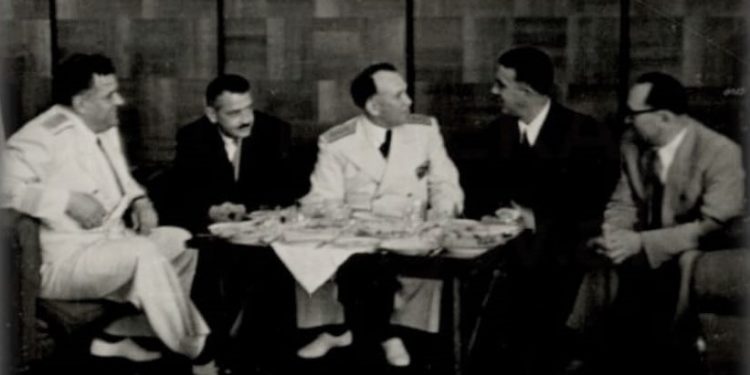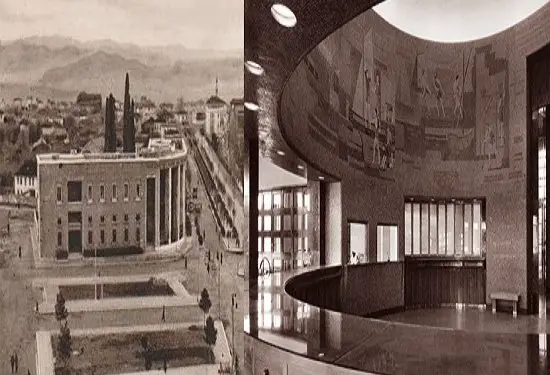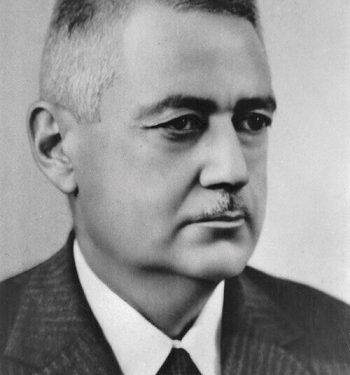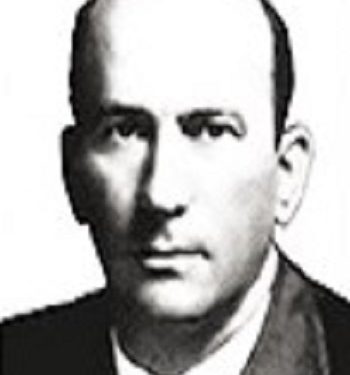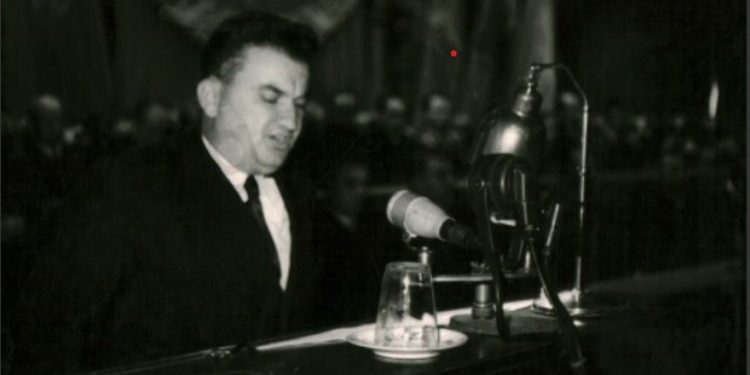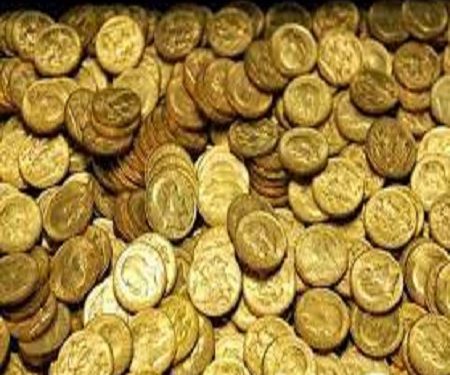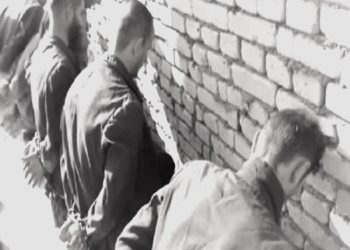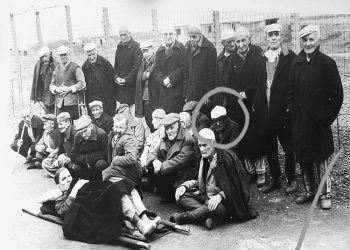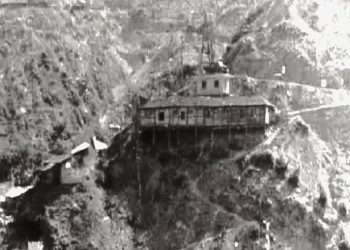By Kastriot Dervishi
Second part
– The names of Albanian merchants and rich people who were robbed by the communist regime and where did the amount of 43,816,682 gold coins collected by the State Security go?!
Memorie.al / An article published years ago, in the magazine “In the service of the people” (former organ of the Ministry of Internal Affairs), by Nuri Mehmeti, has opened a considerable controversy in the years of transition, with the title “When the economic foundations of popular power were laid”. This article was published on pages 14-15 of the August 1984 issue, in the magazine in question, with the headline “40 years of liberation, the path of war and victory”! Later controversy regarding this article arose because the figure of 43,816,682 gold coins mentioned in the article, stolen from the State Security, was an official figure.
Continues from last issue
– WHY DID GOLD GO TO THE SOVIET UNION?!
Another problem related to Albanian gold is the amount of gold that went to the Soviet Union in 1954, in exchange for a quantity of wheat. Such a practice, which may have happened other times with the Soviet Union, almost never happened, for the purchase of food goods. Thus, according to decision no. 144, dated February 2, 1954, “On the import of goods for the special market”, of the Council of Ministers, an amount of 224.4 kg went to the Soviet Union. gold It is worth noting that the entire procedure of the transfer of gold to the Soviet Union was extremely secret. Why did it have to be a secret, from whom were the communist leaders guarded?
The said decision states:
“1- The Ministry of Trade and Communications, to import goods from the USSR for the special market, for a value of 1,000,000 (one million rubles).
2-The Ministry of Finance is tasked with liquidating the above amount, against the value of gold coins.
3-This decision enters into force immediately”.
– THE SECRET RELATION OF THE ALBANIAN STATE BANK, ON DECEMBER 27, 1954
In relation to this, the Bank of the Albanian State, in the highly secret report sent to the Council of Ministers, says:
“Based on the decision of the Council of Ministers, no. 144, dated February 2, 1954, it was decided to import from the USSR, goods for the special market, for an amount of about 1,000,000 rubles. The value of the goods will be liquidated with gold coins. According to the accounting data, the value of the goods arrived amounts to 945,615.58. On our part, before the liquidation of the value of the goods arrived, for the special market, we asked the Bank of the USSR, the price of the purchase of gold, which announced with its letter, dated April 10, 1954, no. 75001, that 1 gram of gold, 1000/000, is 4.45 rubles.
Based on the price offered by the Bank of the USSR, the value of 1,000,000 rubles was calculated. For the liquidation at the price of 4.45 rubles, 1 gram of fine gold, 38,701.75 napolons of gold were needed, with a nominal gross weight of 6.4516 gr., equivalent to a gram of gold, 1000/000; 5.80645.
Based on your order, a barrel was prepared which contained 39 bags, of which 38 bags contained 1000 pieces of napoleon and bag no. and with nominal net weight, 249,691, the barrel has been properly sealed.
According to the agreement we had with the trade representation of the USSR, we personally delivered it to the captain of the steamer “Chiaturi”, who handed us the bill of lading, duly signed for delivery. The Bank of the USSR confirms the receipt of the barrel in order, with its telegram, dated October 6, 1954.
The Bank of the USSR, with its letter dated December 3, 1954, informs us of the receipt of the barrel, as well as the finding in order of the amount of gold sent with these differences.
a- As for the bags, they were in order with their contents, as pieces, i.e., that Napolona took delivery of 38,700, 75 pieces, with the only difference, that he did not take the nominal weight as a basis, but the effective weight , so there was a difference, a few grams of crude gold, 850.907 (with content 900/1000), equal to gold 1000/1000 grams, 765.81. It is implied that, from use, napoleons have a consumption, their effective weight should be taken regularly and not a nominal one, so each gold napoleon has a weight consumption of 0.022 with a content of 900/100.
b- The calculation of the gold received by the Bank of the USSR did not calculate with the price it offered us, based on its letter, dated April 10, i.e., i gram of gold, 1000/1000 rubles 4.45, but 4.50.
The Bank of the USSR, for 38,701.75 napoleons of gold, based on the effective weight, deduces 223,956 grams of gold, 1000/1000 at the price of 4.50 rubles per gram, equal to 1,007,803.98 rubles.
The value of imported goods is 945,615.98
We have to receive roubles………………….. 62,188.40
But as a result of this action, we have these results:
Napolona 38,701.75 x 326 ALL= 12,616,770.50 ALL.
Conversion to rubles 1,007,803.98 = 12,597,500.
The difference against us is 19,220.50 ALL
Gold insurance $ 282 x 50…..ALL14,100.
The difference and total expenses ALL….33,320.50
As a conclusion, of the implementation of the agreement and the liquidation, we have the following results:
a- The amount of gold was calculated at a price of 4.50 grams and not 4.45.
b- The liability against the USSR was liquidated and remains in our favor, an amount of 62,188.40 rubles, for which please let us know, so that we can keep them in free rubles, or ask Moscow to convert them into dollars .
c- Between our purchase price of gold napoleons and the selling price, we have a loss of 19,220.50 ALL, in the entire quantity sold.
ç- For the liquidation of the obligation, we were also charged with gold insurance costs, up to the destination, since the sale was delivered to Moscow.
d- The account of the Ministry of Finance is presented with a credit surplus of 62,188.40 rubles. In case of use, it will be credited with the counter value in ALL, or in case of sale (conversion to dollars or Swiss francs), in this way the account in question is closed.
e- Regarding the insurance expenses as well as the weight difference, we have debited the account of the Ministry of Finance (provisional account in ALL).
ALBANIAN STATE BANK
General Directorate
Tirana on December 27, 1954
– HAS A PART OF THE GOLD BEEN DEPOSITED IN THE SOVIET UNION
The former director of the State Bank, in the years 1947-1950, Pjetër Deda, in 1991, published several articles in the “Republika” newspaper. In one of these articles, dated May 12, 1991, he casts doubt on the amount of gold in the State Treasury in 1949. According to him, the amount he saw this year was many times smaller, than it could be, or could be thought. Mr. Deda himself asks the question that; where was all that amount of seized gold deposited?! According to him, the puzzle is solved by the Bank of the Albanian State itself, if all the inflows and outflows of the Treasury are verified.
Also, he says that; in 1948; there was talk of the treasury; was deposited in the Soviet Union; due to Albania’s security and geographical position. As an additional argument, Mr. Deda, ask that; why was Khrushchev so good to Albania in 1959, when he forgave all the debts.
– DID KHRUSHOVE REALLY FORGIVE ALBANIA’S DEBT?!
On May 25 – June 4, 1959, the general secretary of the Communist Party of the Soviet Union and prime minister of this country, Nikita Sergeevich Khrushchev, at the head of a Soviet party and government delegation, paid a visit to Albania. In this visit, Khrushchev was accompanied by Muhitdinov (member of the Presidium and secretary of the Central Committee of the CPSU), R. Malinovski (Minister of Defense), N. Firjubin (Deputy Minister of Foreign Affairs), A. Bulgarov (Secretary of the CQ of Professional Unions), F. Dumbatze (secretary of the CQ of KP of Georgia), D. Rasulov (secretary of the CQ of Tajikistan), S. Vizarov (deputy prime minister of Azerbaijan) and I. Vinogradov (deputy director of in MFA).
Before the arrival of the high Soviet delegation, there was also a high party and government delegation from Albania in the Soviet Union. Exactly, on the occasion of the New Year 1959, Enver Hoxha mentioned this fact, in the greeting he addressed to the Albanian people. Regarding this and the number of rubles credited by the Soviet Union, among others, Enver Hoxha says in his greeting:
“… In recent weeks, a delegation from the Party and our government was in Moscow. He was always received with extraordinary love by the Central Committee of the Communist Party of the Soviet Union and the Soviet government. Allow me to communicate to you that it only took half an hour of conversation between our delegation and the Soviet comrades, headed by our dear friend Nikita Sergeevich Khrushchev, that all our very great requests for help from of the Soviet Union, for the third 5-year period, to be resolved completely and satisfactorily.
The Soviet Union, in addition to the colossal aid it has given our country in the past, of which you are fully aware, gave us a new loan of 300 million rubles for the third 5-year period, it granted us another 35 million other rubles, only for the development of oil, during these last two years of the second 5-year period, as well as a series of gifts, for the development of the economy and culture, which are estimated at 10 million rubles.
This colossal, generous, internationalist aid can only be given inspired by the high internationalist feeling and the ardent love that the Soviet people and the Communist Party of the Soviet Union have for the people and for our Party. This aid is an extremely large guarantee for the development on a large scale of the economy and culture of our country, as Comrade Khrushchev said, a blooming garden.
All our people, with boundless gratitude, today extend the most ardent thanks to the glorious Soviet Union, the mother communist party of the Soviet Union, its Central Committee and Comrade Nikita Khrushchev. We assure the brotherly peoples that we are bound to them forever with a friendship and loyalty that will never die…” (taken with abbreviations from the newspaper “Zeri i Populli”, dated January 1, 1959).
It was in such an atmosphere that Khrushchev’s visit to Albania was expected to take place. What surprises you in this case is Enver Hoxha’s declaration of a loan amount of 300 million rubles, for the third 5-year term, theoretically starting in 1961. As for the “forgiveness” of Albania’s debts, from Khrushchev, during the last visit to Albania, it seems that it is about the other sums mentioned by Enver Hoxha.
Here, we consider the fact that; for 1 million rubles, from the Albanian State Treasury, 224.4 kg came out. gold If we continue with the same logic, it follows that; for 35 million rubles, 7,854 kg of gold to be paid. If we add here the other 10 million rubles, which Enver Hoxha says, then it turns out that, for these two “loans”, the Soviet Union took Albania, about 10 tons of gold. Such an amount of gold may seem like a lot, but still, in relation to the minimum of 320 tons of gold looted by the communists after the war, it is really small.
As early as the day Khrushchev came to Rinas Airport, Enver Hoxha declared: “The Albanian people value friendship with the Soviet Union as the most precious treasure…! Our friendship is as strong as granite and eternal as our mountains….”! (newspaper “Voice of the People”, May 26, 1959).
As you can see, for Enver Hoxha, the real treasure is no longer important, because the treasure for him was the “eternal friendship” with the Soviet Union. And this eternity was soon seen. At the time when Khrushchev visited Tirana, the Albanian side in the talks consisted of: Enver Hoxha, Mehmet Shehu, Beqir Balluku, Gogo Nushi, Spiro Koleka, Liri Belishova, Manush Myftiu, Koço Theodhosi, Abdyl Këllezi, Adil Çarçani, Maqo Çomo, Behar Pillar and from the Albanian ambassador to the Soviet Union, Nesti Nase.
After various talks and visits throughout Albania, on May 30, 1959, Khrushchev was declared an “Honorary Citizen” of Tirana and on June 3, 1959, he laid the first stone in the Palace of Culture in Tirana, where a plaque was placed with the words: “Here on June 3, 1959, the great leader of the Soviet people and the dear friend of the Albanian people, Comrade Nikita Sergeyevich Khrushchev, laid the first stone in the foundations of the Palace of Culture, an eternal symbol of the indestructible and eternal Albanian friendship. Soviet”.
The receipt of the aforementioned amount of gold by the Soviet Union is another indicator that shows, on the one hand, the lack of solidarity in the socialist camp and on the other hand, the knowledge that the Soviets had about Albanian gold. Also, it should be remembered that; beginning after the great Albanian-Soviet breakdown, there was no great pressure to demand “debts” from the Soviet Union.
Although publicly, they were said to have been issued in 1959, however, it could have been some other amount taken after this year, having the gold in between. It seems that both sides did not want the gold issue to be made public, as it was harmful to both sides. For the Albanian side, the delivery of gold to the Soviet Union was discussed, and for the Soviet side, the bargain came to the fore, to get the Albanian gold.
– WHERE DID 8 TONS OF GOLD AND SILVER GO IN 1968…?!
In 1968, it was the only time, when the communist regime cut commemorative gold and silver coins, in the framework (as it was said) of the 500th anniversary of Skanderbeg’s death. In this regard, the Presidium of the People’s Assembly issued a special decree on January 16, 1968.
Regarding this point, the following discussion took place in the Presidium of the People’s Assembly:
Haxhi Lleshi:……I think that, as a first point, we should start with the review of the draft decree, for the minting of commemorative gold and silver coins, perhaps we also have Alex Verli (at that time Minister of Finance – note).
Tonin Jakova: How much does this Italian who undertakes this (cutting – note) earn? Is he in agreement on how much he will earn? What is the price of gold coin, in terms of common currency? Will other commemorative medallions be made or, only in this case? Then, who will sell them, will he sell them under our control?
Gogo Nushi: This proposal for example that he makes, are they related as a number and as a value? Is it our suggestion or his? They are experts, they are specialists for these jobs, therefore, one thing we must know, to be aware, that they do not enter this job to popularize Skenderbeu. For example, they are bound by the interest of profit.
Aleks Verli: We are entering this work for the first time. Seeing that often foreigners have asked us for such commemorative coins, not only of gold, but also of silver and copper, he encouraged us to enter into such work. From the proposal made by him, we saw the possibility that we could enter such a job.
From the proposal made by him, we saw the possibility that we could access everything and that this could be beneficial for us. He takes over everything, while official authorization is required from us. Now whose advantage is greater? – It is understood by him, we know this and we are conscious, because he starts from the goal of profit, since these coins are sold for twice the value or more.
For example, 10 ALL, if it is worth 1 dollar, he will sell it for 4 dollars. These make the catalog of different coins, which they announce with the value for each coin. They keep the value of the currency, according to the official exchange rate. Our lek is 0.177 thousandths of a gram of gold, i.e., at the legal rate, this is how it is calculated, but we have not announced why we do not have gold coins in cash. In the same way, even socialist countries do not have it…!
Haxhi Lleshi: What about other socialist countries, have they issued similar ones?
Aleks Verli: It doesn’t seem to us that they released it. It turns out that he took out Mao Zedong, but in the medallion, it’s different, they don’t answer to anyone. As for withdrawing money, they cannot do the printing, if they do not receive the authorization from the relevant country. According to the calculations, it turns out that he gives us 30% of the profits, 20% is his expenses, then the banks, the bribes they have, etc. Can we make other coins besides these? We can do. For now, this is what we thought. Regarding the sale term, he asks us for a term of 4-5 years, while we told him up to 3 years. We think that within 3 years, they can be sold.
Tonin Jakova: What is the total amount of gold?
Aleks Verli: It is about 80-82 square meters. gold Now, from the technical side, do we have the opportunities, so that we don’t abuse it? In the agreement, we managed to have these coins issued by 5 well-known houses, two in Italy, one in France, one in Switzerland and one in West Germany. We have the right to control, but there is another thing, that these are very protected from compromise.
Tonin Jakova: If we have the possibilities, can’t we make these coins ourselves?
Aleks Verli: We don’t have the opportunities ourselves. We find it difficult that it is the first time it is done, then these are companies that are known, they have their branches, they have their agents, they are known to all the banks of the world.
Haxhi Lleshi: I think the explanations are clear. Those in finance have seen it, the government has seen it, interest, as presented, we have. That’s why I think we should approve the decree…”!
In this regard, we also browsed the “Official Gazette” of 1968, which already in its number 1, on its pages 2 and 3, contains decree no. 4358, “On the minting of commemorative coins, made of gold and silver”. According to Article 1 of this decree, the Albanian State Bank was authorized to issue an extraordinary series of gold and silver commemorative coins. According to Article 2, these currencies had “legal tender and liberating power, for the regulation of all obligations, bonds and public and private transactions.
In article 3 of the decree, gold coins would be minted with a simple gold content of 900/1000 and a silver-copper alloy of 100/1000. These cuts would be 20, 50, 100, 200 and 500 ALL. On the other hand, the silver coins with simple silver content, 1000/1000, were of denominations of 5, 10 and 25 ALL.
From the gross weight, in grams of the coins, it is noted that the 500 ALL coin weighs more, with 98.74 grams and a diameter of 55 millimeters. For these coins, article no. 5 of the decree in question, provided for the progressive number, from 1 to 12,000.
The entire process of minting coins and then selling them has gone through a labyrinth, not at all transparent. You are impressed by the fact that, for such a symbolic event, not a symbolic amount of gold is spent, but such an amount, which is approximately the entire amount of gold that entered the treasury from 1944 until the end of 1990. Thus, we must affirm that; the total amount of gold introduced (officially) into the treasury; is 8,839 kg., of which, on December 31, 1990, 1,239 kg remained.
No country in the world has seen the total expenditure of the treasury, to mint coins, on a particular festive occasion. Even more so, that the currency in question has completely avoided internal circulation. Memorie.al
The next issue follows





